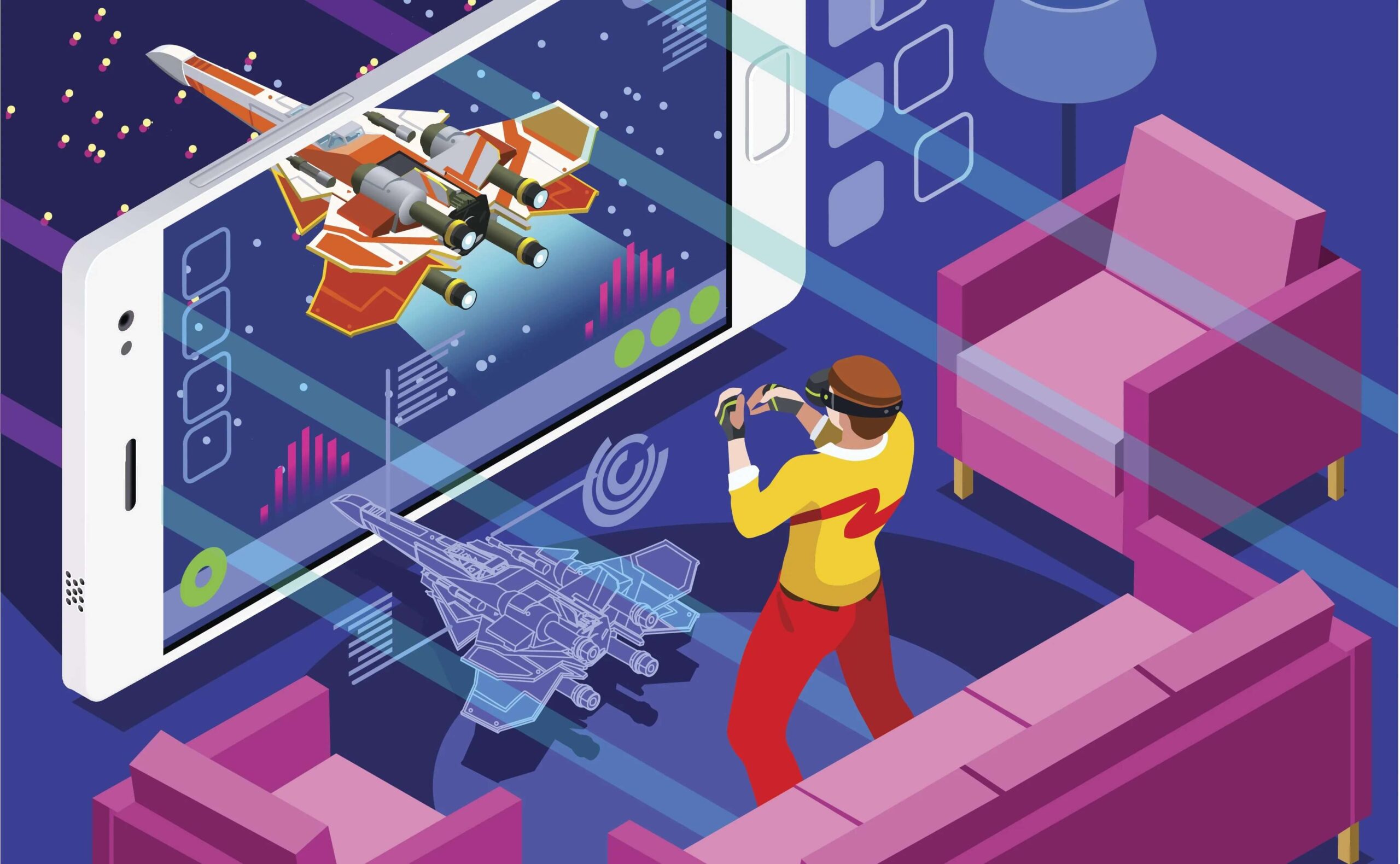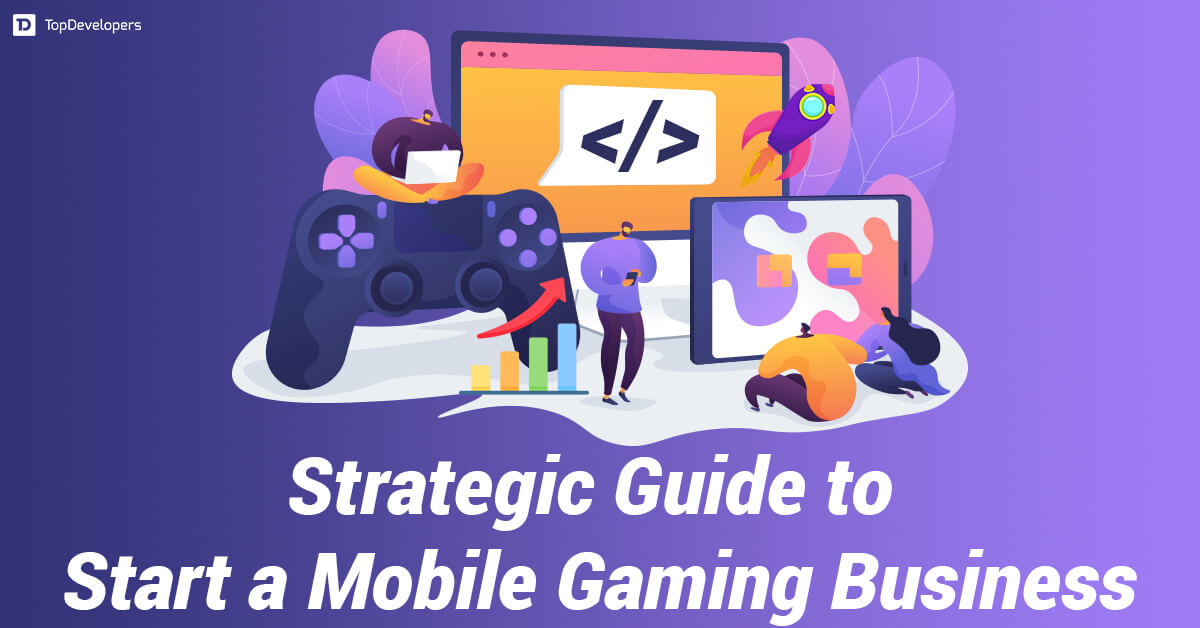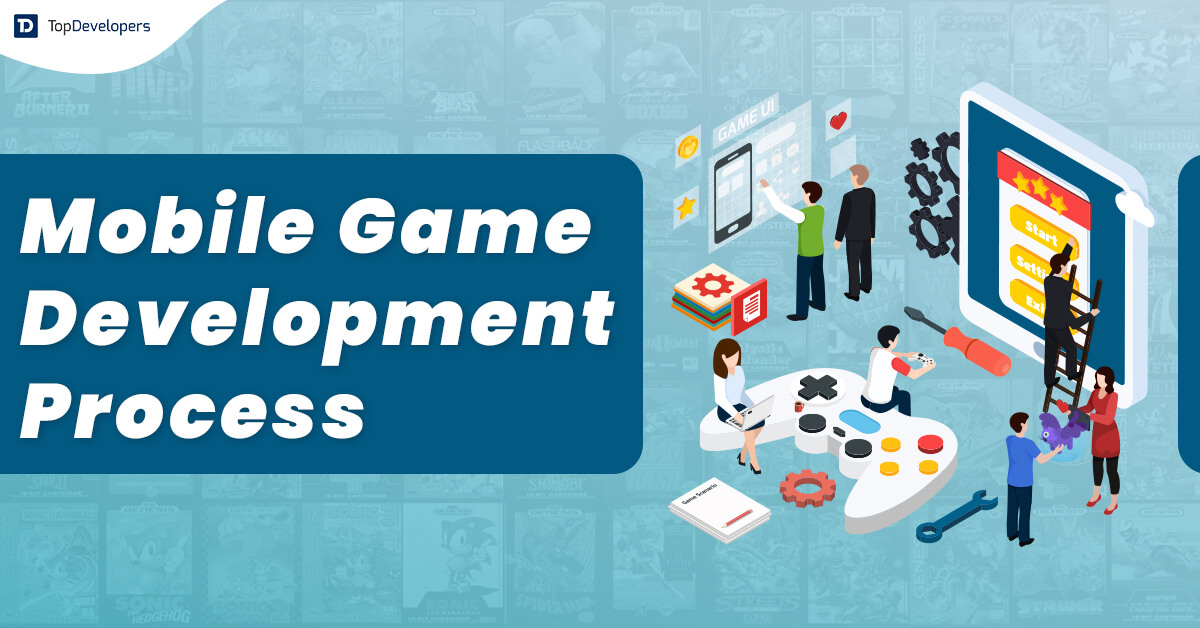
Mobile games hold significant importance in today’s digital landscape. They entertain millions of users globally, enable reaching a mass market, connect people socially, enhance cognitive capabilities, and create business revenue opportunities. That’s why they have become an integral part of modern lifestyle and hold immense cultural and commercial significance.
Mobile device evolution and the latest pandemic are the major drivers that skyrocketed the usage of mobile gaming applications. With over 773,674 mobile games on the App Store and Play Store, businesses are expected to earn $386.50 billion in 2024 as revenue in the Mobile Games market. According to Statista report, It has geared up the businesses to gain a good share of the market volume that’s projected to grow to $376.70 billion by 2027 at an annual growth rate (CAGR 2023-2027) of 7.08%.
However, acquiring the number of users in the mobile gaming market which is expected to amount to 2.32 billion by 2027- is not an easy deal. It requires building a mobile game that steps in with the latest gaming trends. The leading mobile game development companies ensure that all the latest trends must be added while creating the mobile game which helps businesses seize an extra edge over the competition.
Here are the trends that businesses should consider if they are looking to build a mobile game in 2025. Let’s dive in!
Table of Contents
- Top 30+ Mobile Game Development Trends
- Immersive Technologies
- Live Ops Becomes an Essential Monetization Feature
- Hybrid Reality Games
- Hybrid Monetization Model
- Genre-Bending Games
- More Streaming Platforms Enter Mobile Gaming
- Rise of Indie Games
- Puzzle Games Staying Strong
- Digital Twins in Mobile Games
- Cross-Platform Play
- Mobile Gaming
- Eco-Friendly Game Development
- Generative AI
- Crypto Gaming
- 5G Games
- Casual Games
- Gaming Socialization
- Multiplayer Functionalities
- Hybrid Casual Games are Taking Over
- Augmented Reality (AR) Gaming
- Hypercasual Gaming
- AAA Game
- Blockchain Games Are Transforming the Mobile Gaming Ecosystem
- Mobile Cloud Gaming
- Mobile eSports
- Enhanced Monetization Policies
- New Ways to Sidestep Play Store IAP Fees
- Game Streaming and Sharing in Mobile Gaming Market
- AI Leverage in Gaming
- Metaverse in Mobile Gaming
- Which Mobile Game Development Trends will you Choose?
Top 30+ Mobile Game Development Trends
Access to real-time data about future trends is imperative to grow and prosper in the market. Here are most popular mobile game development trends that are currently gaining traction and could potentially continue in the years to come.
Immersive Technologies
Immersive technologies have gained significant traction over the last decade. From education to the gaming sector, immersive technologies such as augmented reality and virtual reality are leveraged to go beyond the limits of conventional offerings. In mobile game development, As the popular mobile game development trend, immersive technologies have transformed the gamer experiences with unparalleled engagement and interactive gameplay.
It has created new possibilities by adding alternate dimensions for gamers wherein gamers can play directly in a gaming environment in addition to a screen. Pokemon Go game is a famous example of immersive technology wherein a surreal world is explored that transmogrifies the users completely. Integrating AR and VR in mobile games eliminated the expensive hardware requirements, improving accessibility.
Under multiplayer playing modes, the combination of AR and VR created shared experiences as it changed how players interact and made them feel as if they were physically communicating and collaborating during the game play. It improves social interaction that contributes to game popularity, such as BGMI, PUBG, etc.
Live Ops Becomes an Essential Monetization Feature
Live Ops (Live Operations) has become a pivotal trend in mobile game development, offering players real-time updates, in-game events, and personalized content to keep gameplay engaging.
Games using Live Ops report higher player retention and revenue growth. For instance, games with dynamic events like limited-time modes or exclusive rewards see a 30% increase in daily active users and significant boosts in monetization. Popular games like Fortnite and Clash Royale showcase this trend by releasing regular challenges and seasonal events to maintain player interest.
Adopting Live Ops enables developers to build player loyalty, create fresh experiences, and drive recurring in-game purchases. This trend is essential for businesses looking to increase engagement and profitability in 2025.
Hybrid Reality Games
Hybrid Reality Games combine the best of Augmented Reality (AR) and Virtual Reality (VR), offering a seamless transition between real and virtual worlds. These games create immersive, interactive experiences without the need for expensive hardware, enhancing accessibility.
For example, hybrid reality titles integrate real-world objects with digital gameplay, allowing players to explore environments with greater realism. As AR and VR technologies advance, this trend is set to redefine mobile gaming in 2025 by merging physical and virtual spaces.
Hybrid Monetization Model
The Hybrid Monetization Model is transforming mobile game revenue strategies by blending multiple monetization methods, such as in-app purchases, ads, and subscription models. This trend ensures a steady income stream while catering to diverse player preferences.
Games like Clash Royale and Call of Duty Mobile combine ad revenue with premium content and subscription perks, maximizing engagement and profits. By integrating these methods, developers create a balanced approach that avoids over-reliance on any single revenue stream.
In 2025, businesses adopting this model will benefit from improved player satisfaction, increased retention, and sustainable growth in revenue.
Genre-Bending Games
Genre-bending games are redefining mobile gaming by blending elements from multiple genres to create unique experiences. For instance, games that combine puzzle-solving with role-playing mechanics or adventure elements with strategy have gained significant traction.
This trend allows developers to attract diverse audiences and keeps players engaged with innovative gameplay. Successful examples include games like Genshin Impact, which blends open-world exploration with action RPG elements.
Genre-bending games will continue to captivate players in 2025, offering fresh and memorable gaming experiences that stand out in a crowded market.
More Streaming Platforms Enter Mobile Gaming
The rise of streaming platforms in mobile gaming is reshaping how players access and enjoy games. Platforms like Netflix and Amazon Prime Gaming are expanding their offerings to include mobile games, creating new opportunities for player engagement.
These platforms provide exclusive titles, seamless streaming, and added value for subscribers. By eliminating the need for downloads or hardware upgrades, they make high-quality gaming more accessible. This 2025 mobile game development trend will continue to grow, encouraging businesses to partner with these platforms to reach wider audiences.
Rise of Indie Games
Indie games are gaining momentum in the mobile gaming space, driven by advancements in development tools and distribution platforms. These games often deliver innovative gameplay and creative storytelling, attracting players looking for unique experiences.
Games like Among Us and Stardew Valley have demonstrated the potential of indie games to achieve massive success. With tools like Unity and Unreal Engine becoming more accessible, indie developers can compete with big studios by creating high-quality games.
The rise of indie games will continue to disrupt the industry in the year 2025, providing fresh content and innovative ideas for players worldwide.
Puzzle Games Staying Strong
Puzzle games continue to dominate the mobile gaming market due to their universal appeal and simple mechanics. Titles like Candy Crush and Monument Valley remain popular across all age groups, thanks to their engaging gameplay and short sessions.
Puzzle games are evolving with new features such as social integration, competitive modes, and meta-layers that enhance player engagement. These additions make puzzle games more interactive while opening new monetization opportunities for businesses.
Digital Twins in Mobile Games
Digital twins, virtual replicas of real-world environments or objects, are revolutionizing mobile games by enhancing realism and interactivity. These models allow players to experience realistic simulations, making strategy and simulation games more immersive.
For instance, digital twins can replicate real-world cities or terrains for adventure games or detailed environments for sports simulations. This trend, powered by advancements in AI and IoT, is expected to drive innovation in 2025 by bridging the gap between virtual and physical worlds.
Cross-Platform Play
One of the popular game development trends in 2025 is cross-platform play, which allows players to play the same game on different devices and platforms using the same account. Cross-platform mobile games like Minecraft and Fortnite are played from desktop to tablet and mobile so game players can play the game on their favorite device and platform.
This capability enables players to play games with their friends on any platform, which improves social engagement and delivers unified experiences. For businesses, choosing and implementing the mobile game development trend of cross-platform play improves users’ interactions when gameplay is facilitated on maximum platforms. Hence, cross-platform gameplay increases access to a broader user base, which, in turn, amplifies revenue generation opportunities.
Mobile Gaming
Mobile gaming is a promising trend in the gaming industry that’s here to stay in 2024 and the years to come. Multiple factors have brought low tides in mobile gaming that take downloads and revenue southwards, but again, it’s shifting to pre-pandemic levels. Hypercasual, RPG genre, shooter, etc, have positively impacted mobile gaming.
The mobile gaming market is expected to exhibit a compound annual growth rate of 7.04%, resulting in a projected market volume of $125.40bn by 2028.
The increase in mobile gaming popularity geared up businesses to harness the potential of mobile gaming trends with mobile game development. Mobile gaming generally has short sessions and simple game mechanics so that games run seamlessly on mobile devices without using high computational power.
Eco-Friendly Game Development
With significant climate changes, every industry vertical is taking initiatives to reduce carbon footprint and become eco-friendly. The mobile game industry is no different, where the commitment to delivering eco-friendly solutions will intensify in 2025. Mobile game developers are more conscious about using sustainable practices during game development and distribution for mobile devices.
Businesses prioritize eco-friendly packaging material usage, game engine optimization to improve energy efficiency, promoting mobile game distribution through digital ways to reduce packaging waste, and leveraging renewable energy such as solar energy to power data centers and game servers.
Generative AI
The mobile game development trend of Generative AI is reshaping the gaming industry with its capability to learn and adapt actions accordingly. It’s refining the mobile gaming space and intriguing next-gen gamers with advanced levels. It allows mobile game development companies to create dynamic content infinitely that delivers second-to-none experiences to the users and gamers repetitively when they visit the game to play.
The global generative AI in the gaming market is estimated to register the highest CAGR of 23.3% and is predicted to reach a valuation of $7,105 million by 2032.
Businesses will have immense opportunities to develop characters mimicking human behavior and fantastic game universes in realistic games that are unpredictable and replayable at the same time. Minecraft, No Man’s Sky, Ludo, etc., are built using generative AI technology that never bored users.
The best aspect of the generative AI trend is it facilitates game updates without criticism because the game gets personalized according to users’ gameplay abilities, builds a new virtual world, and improves gameplay without predictability. This way, it creates a win-win situation for mobile game app developers and game players.
Crypto Gaming
The crypto gaming trend helps businesses stay ahead in the mobile gaming industry, with cryptocurrency as a baseline for highly secure and traceable games. The increasing popularity of cryptocurrency is directly linked to crypto gaming—the crypto game transfers purchased or won items and rewards within the crypto network. As every deposit and transaction is automated with no intermediaries involved, crypto gaming instills a sense of confidence and security in the players.
Crypto networks are blockchain networks where every player on the network has access to an equal amount of data. The decentralized nature of crypto gaming ensures both owners and players have similar authority to gain and use information.
5G Games
The growth of 5G devices market size at a CAGR of 33.5% from 2022 to 2030 is a positive boost for the gaming industry. The advent of 5G technology helped with speed enhancement and latency reduction to 1 millisecond in the games. It signifies instant response time will help create immersive experiences in the online game.
With 5G, players will find zero delays in commands, making playing games more fun, from real-time strategy creation to faster shooting games. Also, it improves mobile game accessibility on smartphones, smart TVs, and tablets with no expensive hardware upgrades required. The stable 5G connection helps in real-time audio and video streaming on devices, and the game is rendered on data servers.
Casual Games
Casual games generally have shorter play sessions and are played with simple rules that make the low barrier to entry. The sub-categories of casual games include popular games such as Candy Crush, Temple Run, Subway Surfer, and My Talking Tom, which have scored high popularity among all generations.
Casual games are closely related to mobile devices, and the integration of competitive elements brought a significant transformation. Merge games and mini-games enhance players’ engagement while blending subgenres and adding meta-layers opens up new business monetization avenues.
Gaming Socialization
The gaming industry has undergone a social transformation. The days are long past when gaming was considered a solo experience because massive online games and social channels enable mobile game players to share their interests with others. Mobile game development trend of Socialization is vital in retaining long-term and mid-term players and increasing ROI.
In casual gaming and multiplayer gaming, socialization is a noticeable shift that’s enhancing user interactions and taking experiences to the next level. The collaborative gameplay that’s a by-product of socialization fosters team spirit and makes the game intellectually stimulating and entertaining.
The significance of social interactions makes mobile game developers incorporate features such as social media integration, voice chat, in-game events, etc, to keep the players engaged in the game.
Multiplayer Functionalities
Multiplayer functionality emerged as an important trend of mobile game development. Now, saying it is a staple of the gaming experience won’t be a hyperbole. 77% of active players willingly play multiplayer games globally. The player’s engagement increases by 3.3% year over year.
Multiplayer games with multiplayer functionalities involve competition, streaming new content, a system for communication, progression with unlockables, and others. 61% of the multiplayer gamers found purchasing downloadable content and continued this purchase for the long term. 31% of these gamers prefer to chat using in-game chat functionality that encourages collaboration and gameplay.
Hybrid Casual Games are Taking Over
Such games blend two different games- casual and mid-core games that combine the accessibility of casual games and retention mechanics of mid-core titles. Hybrid casual games are known for simple and accessible design, including meta features like stories, puzzles, etc., and involve an easy learning curve.
Customization features catering to individual player’s preferences create monetization opportunities. Conclusively, the collectible album usage rate is expected to increase to 70% in a shorter time. For example, AFK Arena- the hybrid casual game provides customization packs to the players for free, which makes players interested in trying free customization packs and later stimulated to buy additional customization packs.
Cross-promotion ability from hyper-casual game titles allows businesses to gain more monetization opportunities with unique, dynamic strategy creation.
Augmented Reality (AR) Gaming
Augmented Reality continues to hold its potential in the gaming industry with immersive and interactive experience delivery. The success of mobile games like Pokémon Go has popularized AR gaming and brought it into the mainstream by generating $34.7 million in revenue in 2024. It is listed as the #7 revenue-generating mobile game worldwide in 2021. This has resulted in increased interest and demand for more AR game experiences.
Advancements in mobile device hardware support the creation of compelling AR games with better graphics, tracking, and environmental mapping. Many AR games incorporate social and multiplayer features that foster social engagement and enhance the multiplayer gaming aspect.
Brands are also using mobile games with Augmented Reality technology as a marketing tool to improve product awareness and enhance user experience. Well, AR games are still in the early stages of development, and there is ample room for innovation and exploration.
Hypercasual Gaming
Hypercasual games remain a dominant force in mobile gaming due to their simplicity, accessibility, and widespread appeal. These lightweight games feature minimalistic designs, short play sessions, and addictive gameplay loops, making them ideal for casual players of all demographics. Titles like Attack Hole, Mob Control, and Magic Tiles 3 continue to captivate audiences globally.
Despite a 24% year-on-year decline in downloads to 2.7 billion in Q4 2022 (Sensor Tower), the hypercasual gaming genre still leads in overall downloads. In 2025, its evolution has been marked by the integration of social features, competitive elements, and hybrid monetization models, enhancing player engagement and retention.
Looking ahead to 2025, hypercasual games are expected to maintain their popularity by leveraging advanced analytics and real-time updates. Developers are focusing on combining hypercasual mechanics with mid-core features, creating a new wave of games that appeal to both casual and competitive gamers.
AAA Game
AAA game in the mobile games industry delivers high-quality, console-like gaming experiences on mobile devices. While mobile platforms traditionally catered to casual and indie (independent) games, the emergence of more sophisticated hardware and increasing consumer demand has paved the way for AAA (Triple-A) game experiences on mobile.
The AAA game strives to deliver immersive experiences and adopt premium pricing structures. Many AAA games adopt a live service model, providing ongoing updates, expansions, and new content to keep players engaged and invested in the game over an extended period.
Genshin Impact, which is a AAA game from miHoYo (Game development company) has surpassed $3 billion in revenue in global lifetime player spending after six months across the App Store and Google Play since its official launch.
Blockchain Games Are Transforming the Mobile Gaming Ecosystem
Blockchain games are undergoing a significant transformation. Although the industry faced challenges, such as a temporary decline in user adoption and game development slowdowns, blockchain gaming is projected to see renewed growth in 2025.
According to the latest reports, the blockchain gaming market is expected to grow by 68% year-on-year, with the number of active blockchain gamers surpassing 1.2 million by mid-2025. Investments in blockchain gaming exceeded $3 billion in 2024, signaling a bright future.
Blockchain gaming facilitates player-centric ecosystems by allowing true ownership of in-game assets through NFTs and enabling secure, transparent transactions via decentralized networks. These features make blockchain games a preferred choice for businesses aiming to attract tech-savvy gamers.
Mobile Cloud Gaming
When we look at the mobile game market trends, mobile cloud gaming has been gaining momentum in recent years, transforming the way people play games on mobile devices. It allows users to stream high-quality, resource-intensive games directly to their mobile devices without the need for powerful hardware. The improved accessibility to a wide range of games instantly has democratized access to high-quality gaming experiences.
The continuous expansion of game libraries offers a diverse selection of popular and critically acclaimed titles. Players can enjoy a wide range of games, including AAA titles and indie gems, without the need to download or install them individually. The integration with existing gaming ecosystems allows users to access their game libraries and progress across multiple devices.
GaaS stands for Gaming As A Service which comes under Mobile cloud computing.
Mobile eSports
The mobile esports game trend encompasses the emergence and growth of competitive esports games specifically designed and optimized for mobile devices. Certain genres have gained prominence in mobile esports, including battle royale games, multiplayer online battle arena (MOBA) games, first-person shooters (FPS), and card-based strategy games. These genres offer competitive gameplay mechanics, player vs player (PvP) and multiplayer features suitable for esports competitions.
It includes features specifically tailored for competitive play such as robust matchmaking systems, ranking systems, leaderboards, spectating modes, and the ability to organize and participate in tournaments or leagues. Major esports organizations have established dedicated leagues and tournaments for mobile esports. These events feature professional players and teams competing for substantial prize pools, further legitimizing the mobile esports scene.
The increased gaming investment, engagement activity, and demand for legal tournament infrastructure contributing to the growth of the global eSports market that’s projected to grow from $1.72 billion in 2024 to $6.75 billion by 2030 at a CAGR of 21.5% during the forecast period.
Enhanced Monetization Policies
The monetization policies of mobile gaming have undergone significant changes over the years, driven by evolving consumer preferences, regulatory developments, and industry practices. There’s a shift to Loot boxes and gacha mechanics that involve randomized virtual item rewards, often obtained through in-app purchases.
These mechanics have faced scrutiny due to concerns about their resemblance to gambling, leading to regulatory interventions in some jurisdictions. 18 nations have cited some of the games that are encouraging players to spend money on virtual items. The European Parliament has initiated action and Australia’s proposed legislation for loot boxes and other monetization methods.
The move toward a transparent monetization model proves to be rewarding for gaming players.
New Ways to Sidestep Play Store IAP Fees
In-app purchases have become a key revenue stream for mobile games. The gaming mobile apps offer various virtual goods, upgrades, or additional content within the game that can be purchased by players, enhancing their gameplay experience or providing cosmetic enhancements. However, Apple and Google Play stores cut 30% of the amount directly from purchases.
The mobile game publishers have launched external web stores for IAPs that sell virtual goods or premium content at discounted rates at scale. Clash of Clans, conquest, and State of Survivals are some of the game publishers that have enabled buying currencies from external platforms to increase profit margins.
Game Streaming and Sharing in Mobile Gaming Market
The game streaming and sharing trend is driven by advancements in technology and the growing demand for interactive and social gaming experiences. It involves players streaming their gameplay live over the internet or sharing recorded gameplay videos with others.
Twitch, YouTube Gaming, and Facebook Gaming are dedicated game streaming platforms that allow players to broadcast their gameplay live to an audience of viewers who can interact through chat and participate in the gaming community. Game streaming and sharing aimed to foster social interaction and community building among players.
AI Leverage in Gaming
Mobile games are increasingly incorporating Artificial Intelligence (AI) technology to enhance gameplay, improve player experiences, and provide new gaming possibilities. AI-powered non-player characters (NPCs) and virtual characters in games have become more sophisticated, with improved decision-making capabilities, natural language processing, and realistic behaviors.
AI algorithms generate game content, such as levels, maps, quests, and missions, dynamically and procedurally. Analyzing the player’s behavior and preferences, the game difficulty or mechanics is adjusted in real-time to provide a personalized and challenging experience. Chatbots and virtual assistants are also integrated to provide support, answer player queries, and offer in-game guidance.
Metaverse in Mobile Gaming
The metaverse refers to a virtual, immersive, and interconnected digital world where users can interact with each other and digital entities in real-time. It is expected to have a significant impact on the future of mobile gaming as a research project the metaverse mobile gaming market to be worth around $119.2 billion by 2028.
Mobile game apps integrating metaverse features allow players to continue their progress across different devices, including mobile phones, tablets, PCs, and gaming consoles. By incorporating user-generated content tools, the players can design and customize their characters, environments, and gameplay elements, fostering creativity and community engagement.
The metaverse concept extends beyond the boundaries of a game app and integrates real-world data and experiences by incorporating location-based features that allow players to explore virtual worlds tied to real-world landmarks and events.
Which Mobile Game Development Trends will you Choose?
According to Research and Markets, The mobile gaming market is projected to grow from USD 100.54 billion in 2024 to approximately USD 164.81 billion by 2029, with a compound annual growth rate (CAGR) of 10.39% over the forecast period. The mobile gaming market growth is accompanied by business revenue. It indicates it’s high time for businesses to start a new venture with the launch of an innovative mobile game in association with one of the top mobile game development companies.
However, the mobile game development industry is highly dynamic, and new trends are expected to emerge or gain prominence. To stay up to date with the latest trends, it’s recommended to follow the trends while developing a mobile game that syncs with your mobile game genre. It helps in maximizing app downloads, improving user experience, and increasing business ROI.
Hire a mobile game developer, if you are unsure how to incorporate these trends in your game or build a new mobile game including the trends. The mobile game developers help you better understand where you can incorporate trends while analyzing mobile gaming activities and build the mobile game following the right mobile game development process. Let’s play!
FAQs About Mobile Game Development Trends
What is the future of the mobile gaming industry?
The technological innovations brought to the gaming industry by AI, AR, VR, 4K graphics, metaverse, and others revolutionizing the gaming industry. It ensures the future of the mobile gaming industry is bright.
How can I find the best mobile game developers for my project requirements?
Search for mobile game developers on online directories, online hiring platforms, or game development communities, and then check their expertise and experience in mobile game design and development.
How much does it cost to develop a mobile game?
Mobile game development cost range starts from between $15,000-$50,000 depending on the game’s complexity, number of platforms, design, and other factors.
How long does it take to develop a mobile gaming solution?
Building a mobile game solution from scratch takes approximately 1 to 4 years that depends on the mobile game category, technology leveraged, and assets need to create.
 Avantika Shergil
| Dec 16, 2024
Avantika Shergil
| Dec 16, 2024
Avantika Shergil is a technology enthusiast and thought leader with deep expertise in software development and web technologies. With over 8 years of experience analyzing and evaluating cutting-edge digital solutions, Avantika has a knack for demystifying complex tech trends. Her insights into modern programming frameworks, system architecture, and web innovation have empowered businesses to make informed decisions in the ever-evolving tech landscape. Avantika is passionate about bridging the gap between technology and business strategy, helping businesses build customized software and website, and understand about different tools to leverage effectively for their ventures. Explore her work for a unique perspective on the future of digital innovation.










